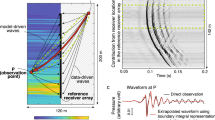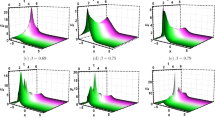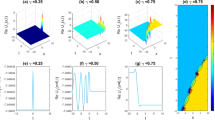Abstract
WAVES at the interface between two Isotropic solid half-spaces subject to continuity of stress and displacement were first studied by Stoneley1 in 1924 and subsequently by other geophysicists, notably Sezawa and Kanai2. In 1947, Scholte3 discussed the range of existence of such waves and Owen4 has shown that out of 900 isotropic materials, only thirty combinations provide an interface along which a Stoneley wave can propagate.
This is a preview of subscription content, access via your institution
Access options
Subscribe to this journal
Receive 51 print issues and online access
$199.00 per year
only $3.90 per issue
Buy this article
- Purchase on SpringerLink
- Instant access to full article PDF
Prices may be subject to local taxes which are calculated during checkout
Similar content being viewed by others
References
Stoneley, R., Proc. Roy. Soc., 245A, 213 (1924).
Sezawa, K., and Kanai, K., Bull. Earth Res. Inst., 17, 1 (1939).
Scholte, J. G., Mon. Not. Roy. Astr. Soc. Geophys. Suppl., 5 (1947).
Owen, T. E., Prog. Appl. Mat. Res. (GB), 6, 69 (1964).
Lim, T. C., and Farnell, G. W., J. Appl. Phys., 39, No. 9, 4319 (1968).
Burridge, R., Quart. J. Mech. Appl. Math. (in the press).
Author information
Authors and Affiliations
Rights and permissions
About this article
Cite this article
LIM, T., MUSGRAVE, M. Stoneley Waves in Anisotropic Media. Nature 225, 372 (1970). https://doi.org/10.1038/225372a0
Received:
Published:
Issue date:
DOI: https://doi.org/10.1038/225372a0
This article is cited by
-
Resonance phenomena in layered media: merging proper and quasi-resonances
Zeitschrift für angewandte Mathematik und Physik (2023)
-
Extinction of Stoneley waves in stratified media with diffused interfaces
International Journal of Mechanics and Materials in Design (2021)
-
Antiplane Stoneley waves propagating at the interface between two couple stress elastic materials
Acta Mechanica (2021)
-
On disappearing Stoneley waves in functionally graded plates
International Journal of Mechanics and Materials in Design (2021)
-
Stoneley waves at the generalized Wiechert condition
Zeitschrift für angewandte Mathematik und Physik (2020)



